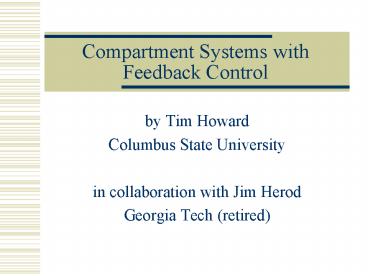Compartment Systems with Feedback Control PowerPoint PPT Presentation
1 / 26
Title: Compartment Systems with Feedback Control
1
Compartment Systems with Feedback Control
- by Tim Howard
- Columbus State University
- in collaboration with Jim Herod
- Georgia Tech (retired)
2
Reference
- Mathematical Techniques for Biology and Medicine
by William Simon, Dover Publishing Inc New
York, 1986.
3
Presentation Outline
- Review one compartment model w/feedback control
- Two-compartment systems with feedback control
pooling delays - Three-compartment systems with feedback control
4
One Compartment Setup
- Compartments conceived as tanks of fluid
5
Stability Questions
- Question 1 How does the system respond to
abrupt changes in the fluid volume? - Question 2 How does the system respond to
abrupt changes in the outflow rate?
6
1-Tank DE
7
Question 1, Change Tank Vol.
- Abruptly add Q to tank while at steady state
- See analysis in Maple
- Original steady state restored
8
Question 2, Change Outflow
- Larger r values desired for optimal control
9
1-Tank with Pure Time Delay
- Delays may cause overcompensation
- Smaller r values prevent growing oscillations
- Larger r values to react to abrupt outflow
changes - Pure time delays relatively rare
10
2-Tank Model Pooling Delay
- A tank separates inflow from objective tank
11
Pooling Delay a look at the first tank
- Outflow rate proportional to volume
- Steady state is VSS Rin / k
- Outflow Rout Rin
12
1st tank w/changing inflow
- What happens when inflow changes?
- See Maple analysis of outflow
13
Pooling Delay w/Feedback Graphical Layout
14
Pooling Delay w/Feedback DEs
- Steady state
15
Pooling Delay w/Feedback
- See analysis in Maple
16
Summary, changes in V1
- Abrupt change in V1 homogeneous d.e.
17
Summary, change in outflow
- Abrupt change in RB nonhomogeneous d.e.
18
Solving the diff. eq.s
- Use customary method for 2nd order d.e.s
- Recall harmonic oscillator (damping)
- Resume analysis in Maple
19
Summary, over damped case
- Change V1 return to steady state w/out
overshooting - Change RB permanent change in steady state
- Minimize change w/large r value
- Limited control since r lt k1 / 4
- resume Maple analysis
20
Summary, critically damped case
- Change V1 return to steady state w/out
overshooting - Change RB permanent change in steady state
- Minimize change w/large r value
- Limited control since r k1 / 4
- resume Maple analysis
21
Summary, under damped case
- Change V1 return to steady state w/overshooting
- Change RB permanent change in steady state
- Minimize change w/large r value
- More control since r gt k1 / 4
22
Overall summary, 2 tanks
- No overshooting, limited control
- Better control possible with overshooting
- Probs. w/overshooting, e.g. hypoglycemia
23
Three Compartment System Figure
24
Three Compartment System DEs
- Analyze in Maple
25
Three Compartment System Summary
- Oscillating inputs magnified
- If r gt k1 k2 , system highly unstable
26
Thank You for Coming
- Email thoward_at_colstate.edu
- WWW http//math.colstate.edu/thoward/

